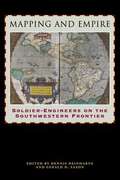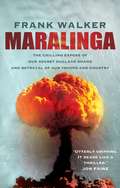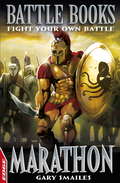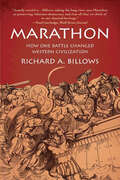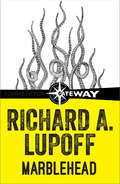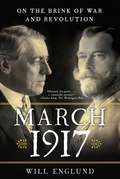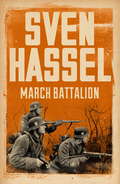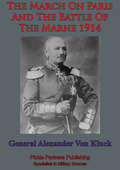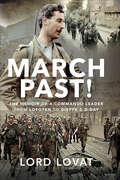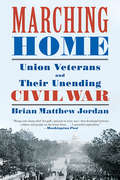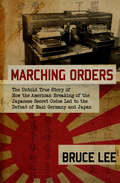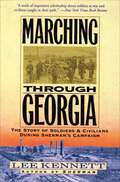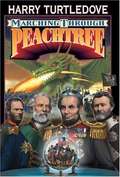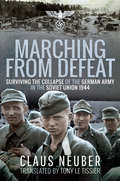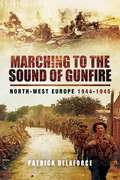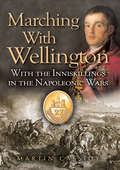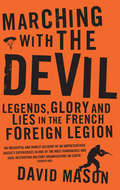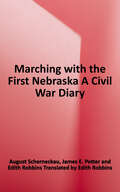- Table View
- List View
Mapping and Empire: Soldier-Engineers on the Southwestern Frontier
by Dennis Reinhartz Gerald D. SaxonFrom the sixteenth through the mid-nineteenth centuries, Spain, then Mexico, and finally the United States took ownership of the land from the Gulf Coast of Texas and Mexico to the Pacific Coast of Alta and Baja California—today's American Southwest. Each country faced the challenge of holding on to territory that was poorly known and sparsely settled, and each responded by sending out military mapping expeditions to set boundaries and chart topographical features.
Maralinga: The chilling expose of our secret nuclear shame and betrayal of our troops and country
by Frank WalkerWho really paid the price for the British nuclear tests in the Australian outback?In the 1950s and 60s, the British government, working with the Australian government, conducted nuclear tests at Monte Bello Island, Emu Field and Maralinga in central Australia. This is the shocking story of how some 8,000 servicemen were used as guinea pigs. Airmen were ordered to fly into the ballooning mushroom clouds minutes after the nuclear bombs exploded. Sailors were ordered to stand on their ships to watch the explosions and later felt the radioactive dust land on their bare skin. Soldiers were ordered to drive into the heart of the blast zone as soon as it had cooled down enough to collect instruments recording the radiation. All by order of their own government.These servicemen stood in shorts and shirts as British and Australian scientists encased in full radioactive suits checked them for radiation exposure. Scientists aware of the dangers showered and scrubbed after each exposure, while the military personnel were not even told of the health dangers they faced. With exclusive access to hundreds of nuclear veterans, journalist Frank Walker reveals never-before published testimony about what really happened at these now notorious nuclear test sites ? and why it still matters.From the government of Sir Robert Menzies onwards, these men have been betrayed. The only job of these nuclear veterans was to serve their country. Our veterans followed orders, walked into British nuclear bomb clouds and emerged to find that despite this toxic exposure, they don?t have the same rights as other veterans. Why? Because they didn?t serve in wartime and didn?t serve overseas. Because the damage was done at home.Maralinga is the chilling story of our secret nuclear shame. It is a story that MUST be told so nothing like it can ever be repeated.
Marathon: Battle Books
by Gary Smailes Ollie CuthbertsonTake up your weapons and prepare to fight your own battle in these all-action, interactive adventures, in which you take part in epic battles from throughout history.It is 490 BCE and the ancient city of Athens is under threat. The Persians have sailed across the ocean to invade your land, and now camp on the plains of Marathon, just a few miles from Athens. You are Miltiades, an old warrior with one last chance to prove your loyalty to the city you love. You will command the mighty Greek Hoplite army as it attempts to halt the Persian invasion and save Athens...
Marathon: Fight Your Own Battle (EDGE: Battle Books #4)
by Gary SmailesTake up your weapons and prepare to fight your own battle in these all-action, interactive adventures, in which you take part in epic battles from throughout history.It is 490 BCE and the ancient city of Athens is under threat. The Persians have sailed across the ocean to invade your land, and now camp on the plains of Marathon, just a few miles from Athens. You are Miltiades, an old warrior with one last chance to prove your loyalty to the city you love. You will command the mighty Greek Hoplite army as it attempts to halt the Persian invasion and save Athens...
Marathon: How One Battle Changed Western Civilization
by Richard A. BillowsThis lively ancient history demonstrates how the Athenian victory against Persian invaders was critical to the development of Western society. The Battle of Marathon in 490 B.C. is widely considered the most decisive event in the struggle between the Greeks and the Persians. In Marathon, historian Richard Billows goes further, arguing that it was also the most significant moment in our collective history. As 10,000 Athenian citizens faced a Persian military force of more than 25,000, Greek victory appeared impossible. But the men of Athens were tenacious and the Persians were defeated. Following the battle, the Athenian hoplite army ran 26.5 miles from Marathon to Athens to defend their port from the Persian navy. Greek freedom ensued and the achievements of the culture became much of the basis for Western civilization.
Marblehead: Lovecraft Book 2
by Richard A. LupoffMarblehead encompasses all of 1927, a year in which H.P. Lovecraft, researching a book he'd been hired to write for the Nazis, travels the East Coast in the company of Charles Sylvester Viereck.
Marcel's Letters: A Font and the Search for One Man's Fate
by Carolyn PorterFinalist for the 2018 Minnesota Book AwardA graphic designer’s search for inspiration leads to a cache of letters and the mystery of one man’s fate during World War II.Seeking inspiration for a new font design in an antique store in small-town Stillwater, Minnesota, graphic designer Carolyn Porter stumbled across a bundle of letters and was immediately drawn to their beautifully expressive pen-and-ink handwriting. She could not read the letters-they were in French-but she noticed all of them had been signed by a man named Marcel and mailed from Berlin to his family in France during the middle of World War II.As Carolyn grappled with designing the font, she decided to have one of Marcel’s letters translated. Reading it opened a portal to a different time, and what began as mere curiosity quickly became an obsession with finding out why the letter writer, Marcel Heuzé, had been in Berlin, how his letters came to be on sale in a store halfway around the world, and, most importantly, whether he ever returned to his beloved wife and daughters after the war.Marcel’s Letters is the incredible story of Carolyn’s increasingly desperate search to uncover the mystery of one man’s fate during WWII, seeking answers across Germany, France, and the United States. Simultaneously, she continues to work on what would become the acclaimed P22 Marcel font, immortalizing the man and his letters that waited almost seventy years to be reunited with his family.
March 1917: On the Brink of War and Revolution
by Will EnglundA riveting history of the month that transformed the world’s greatest nations as Russia faced revolution and America entered World War I. “We are provincials no longer,” declared Woodrow Wilson on March 5, 1917, at his second inauguration. He spoke on the eve of America’s entrance into World War I, just as Russia teetered between autocracy and democracy. In the face of chaos and turmoil in Europe, Wilson was determined to move America away from the isolationism that had defined the nation’s foreign policy since its inception and to embrace an active role in shaping world affairs. Just ten days later, Tsar Nicholas II abdicated the Russian throne, ending a three-centuries-long dynasty and plunging his country into a new era of uncertainty, ultimately paving the way for the creation of a Soviet empire. Within a few short weeks, at Wilson’s urging, Congress voted to declare war on Germany, asserting the United States’ new role as a global power and its commitment to spreading American ideals abroad. Yet at home it remained a Jim Crow nation, and African Americans had their own struggle to pursue. American women were agitating for the vote and a greater role in society, and labor strife was rampant. As a consequence of the war that followed, the United States and Russia were to endure a century of wariness and hostility that flickers and flares to this day. March 1917 reexamines these tumultuous events and their consequences in a compelling new analysis. Drawing on a wealth of contemporary Russian and American diaries, memoirs, oral histories, and newspaper accounts, Pulitzer Prize–winning journalist Will Englund creates a highly detailed and textured account of the month that transformed the world’s greatest nations. March 1917 considers the dreams of that year’s warriors, pacifists, activists, revolutionaries, and reactionaries, and demonstrates how their successes and failures constitute the origin story of our complex modern world.
March Battalion
by Sven HasselDanger was forgotten, death was forgotten, the war was forgotten. They only knew they had to kill... The figures in khaki were no longer soldiers, no longer men. Sven Hassel and his comrades are once more hurled into the ferocity of the frontline.The Eastern Front is a sight of unprecedented destruction. The soldiers there - the tank battalions of Hitler's penal regiments - are considered expendable by the German high command. Treated like animals, they learn to live like animals, to fight like beasts. The only other option is to die a bloody death... This is a gripping testament to the soldiers sacrificed on the Russian Front.
March Battalion
by Sven HasselInto the screaming inferno of the Russian Front were thrown the Tank Battalions of Hitler’s Penal Regiments – men whose lives were considered expendable by the German High Command. And because they were treated like animals, they learned to live like animals – to steal and cheat in the manner of beasts – to fight, not only the enemy but each other – to die, brutally and bloodily… These were the men sacrificed in the Fuhrer’s Russian Offensive…the men of March Battalion.
March Forth
by Trevor Greene Debbie GreeneAt the age of forty-one, Trevor Greene, a journalist and a reservist in the Canadian Forces, was deployed to Afghanistan, leaving behind his fiance, Debbie, and his young daughter, Grace. On March 4, 2006, while meeting with village elders in a remote village in Kandahar Province, Trevor removed his helmet, confident that a centuries-old pact would protect him from harm. Without warning, a teenage boy under the influence of the Taliban walked up to him and landed a rusty axe in his skull, nearly splitting his brain in two. Initially, Debbie was told that Trevor would not survive. When he did, she was told that he would never be able to communicate or move on his own. But after years of rehabilitation, setbacks and crises, Trevor not only learned how to talk and move again, but in July 2010, he stood up at his wedding, Debbie at his side and Grace carrying their rings down the aisle as their flower girl. March Forth is a remarkable story of love told in two voices: first in Trevor's, up until the attack; then in Debbie's, as she works tirelessly to rehabilitate her fiance. Together, Trevor and Debbie have written the next chapter in their remarkable story.
March On Paris And The Battle Of The Marne 1914
by General Alexander Von Kluck"Long-out-of-print account of the first weeks of the Great War by Alexander von Kluck, Commander of the German First Army, which fought and lost the decisive Battle of the Marne after clashing with the BEF at Mons and Le Cateau. ...Von Kluck was given the crucial role in 1914 of commanding the German First Army, the 'fist' of the famous Schlieffen Plan to knock out France in a lightning six-week campaign. Kluck's mission was to march through Belgium (bringing Britain into the war), drive through north-east France and scoop up Paris, thus trapping the main French armies between their capital and the Franco-German frontier where the German left-wing was waiting. Kluck did all that was asked of him, but when Schlieffen's plan left the drawing board and was tested on the battlefield, it began to unravel. Firstly, the British Expeditionary Force arrived in France much faster than the Germans had expected, fighting delaying actions against Kluck at Mons and Le Cateau. Secondly, as he approached Paris, Kluck's exhausted army began to lose touch with the Second Army of von Bulow to their left. Crucially, Kluck sidestepped westwards to keep in touch with Bulow, thus giving France's General Joffre the chance to launch the counterstroke attack on his flank that became the Battle of the Marne; a series of engagements which first checked, then reversed, the hitherto victorious German onslaught. Cyril Falls, doyen of Britain's Great War historians, called Kluck's book "One of the most interesting and important of German war books'. Written with all the headstrong fierceness which made Kluck famous, this book is one which no student of the Great War will want to miss. It comes complete with maps, an appendix giving the First Army's Order of Battle, and a frontispiece photograph of the author."--N&M Press Reprint
March Past: The Memoir of a Commando Leader, From Lofoten to Dieppe & D-Day
by Lord LovatAt the outbreak of war in 1940, Simon Frazer, the 15th Lord Lovat and a former Guards officer, was mobilized from the reserve list to join the Lovat Scouts, the British Army’s first sniper unit that had been formed by his father during the Boer War. The following year he volunteered for one of the new Commando units then being created. Lovat was personally involved in the training of the Commando troops on the West coast of Scotland. He was eventually attached to, and led, No.4 Commando. On 3 March 1941, Nos. 3 and 4 Commando launched a raid on the German-occupied Lofoten Islands. In this successful attack, Operation Claymore, the commandos destroyed fish-oil factories, petrol dumps, and even eleven ships. They also seized encryption equipment and codebooks, as well as captured 216 German troops. Promoted to temporary major, Lovat led 100 men of No.4 Commando and a 50-man detachment from the Canadian Carleton and York Regiment in a raid on the French coastal village of Hardelot in April 1942. For this action he was awarded the Military Cross on 7 July that year. Lord Lovat was involved in further raids against the German-held French coast, most notably Dieppe, during which No.4 Commando destroyed the coastal battery at Varengeville-sur-Mer in a textbook commando attack. This resulted in Lovat being awarded the DSO. Such was the effect the Commando raids had on German morale, Lovat had 100,000 Reichmarks placed on his head, dead or alive. Promoted to brigadier, Lovat formed the 1st Special Service Brigade (later the 1st Commando Brigade) which stormed ashore on D-Day to secure the eastern flank of the attacking forces. In this, he famously instructed his personal piper, Bill Millin, to pipe the commandos and himself ashore, in defiance of specific orders not to allow such an action in battle. In the subsequent fighting Lovat was seriously wounded, effectively ending his active career. These are the memoirs of one of the most remarkable fighting figures of the Second World War, who was involved in some its more exciting and dangerous operations. Despite his aristocratic ancestry, he led from the front and, without doubt, Simon Frazer, Lord Lovat was a soldiers’ soldier.
Marching Home: Union Veterans and Their Unending Civil War
by Brian Matthew JordanA groundbreaking investigation examining the fate of Union veterans who won the war but couldn't bear the peace. For well over a century, traditional Civil War histories have concluded in 1865, with a bitterly won peace and Union soldiers returning triumphantly home. In a landmark work that challenges sterilized portraits accepted for generations, Civil War historian Brian Matthew Jordan creates an entirely new narrative. These veterans-- tending rotting wounds, battling alcoholism, campaigning for paltry pensions-- tragically realized that they stood as unwelcome reminders to a new America eager to heal, forget, and embrace the freewheeling bounty of the Gilded Age. Mining previously untapped archives, Jordan uncovers anguished letters and diaries, essays by amputees, and gruesome medical reports, all deeply revealing of the American psyche. In the model of twenty-first-century histories like Drew Gilpin Faust's This Republic of Suffering or Maya Jasanoff 's Liberty's Exiles that illuminate the plight of the common man, Marching Home makes almost unbearably personal the rage and regret of Union veterans. Their untold stories are critically relevant today.
Marching Into Darkness
by Waitman Wade BeornOn October 10, 1941, the entire Jewish population of the Belarusian village of Krucha was rounded up and shot. While Nazi death squads routinely carried out mass executions on the Eastern Front, this particular atrocity was not the work of the SS but was committed by a regular German army unit acting on its own initiative. Marching into Darkness is a bone-chilling exposé of the ordinary footsoldiers who participated in the Final Solution on a daily basis. Although scholars have exploded the myth that the Wehrmacht played no significant part in the Holocaust, a concrete picture of its involvement at the local level has been lacking. Among the crimes Waitman Wade Beorn unearths are forced labor, sexual violence, and graverobbing, though a few soldiers refused to participate and even helped Jews. By meticulously reconstructing the German army's activities in Belarus in 1941, Marching into Darkness reveals in stark detail how the army willingly fulfilled its role as an agent of murder on a massive scale. Early efforts at improvised extermination progressively became much more methodical, with some army units going so far as to organize "Jew hunts. " Beorn also demonstrates how the Wehrmacht used the pretense of anti-partisan warfare as a subterfuge by reporting murdered Jews as partisans. Through archival research into military and legal records, survivor testimonies, and eyewitness interviews, Beorn paints a searing portrait of a professional army's descent into ever more intimate participation in genocide.
Marching Orders: The Untold Story of How the American Breaking of the Japanese Secret Codes Led to the Defeat of Nazi Germany and Japan
by Bruce Lee"Breaking the Japanese codes shortened the course of the war by two years." --General S. J. Chamberlin, General MacArthur's operations officer. Proclaimed "one of the most important books ever published on World War II," Marching Orders provides a stunning account of how the American military's breaking of the Japanese diplomatic Purple codes led to the defeat of Nazi Germany. Bruce Lee, having had access to more than one million pages of US Army documents and thousands of pages of daily top-secret messages dispatched to Tokyo from the Japanese embassy in Berlin, assembles fascinating revelations about pivotal moments in the war, including the reason Eisenhower stopped his army at the Elbe and let the Russians capture Berlin, the invasion of Europe, and the battles on the African and Eastern fronts. Magic and Ultra were the names of the Allied code-breaking efforts that unlocked the secrets of the Axis powers. One of the most extraordinary takeaways from these ingenious deciphering activities was the fact that Japanese leaders were intransigent in their refusal to surrender, which led to the strategic and fateful decision to drop the atomic bomb and force an end to the conflict in which thousands of lives would have been lost. This groundbreaking book clearly demonstrates how the success of the American code breakers led to so many favorable military and strategic outcomes for the Allies and hastened the end of this devastating war.
Marching Through Georgia: The Story of Soldiers & Civilians During Sherman's Campaign
by Lee B. KennettIn this engrossing work of history, Lee Kennett brilliantly brings General Sherman's 1864 invasion of Georgia to life by capturing the ground-level experiences of the soldiers and civilians who witnesses the bloody campaign. From the skirmish at Buzzard Roost Gap all the way to Savannah ten months later, Kennet follows the notorious, complex Sherman, who attacked the devastated the heart of the Confederacy's arsenal. Marching Through Georgia describes, in gripping detail, the event that marked the end of the Old South.
Marching Through Peachtree (The War Between the Provinces #2)
by Harry TurtledoveFREE THE BLONDS! (America's Civil War Turned Upside Down) A terrible civil war was tearing apart the kingdom of Detina, a land which could no longer be half serf and half free. When the new ruler, King Avram, announced his intent to liberate the blond serfs upon which the northern provinces depended, Detina was torn in two, and the rebellious north took Avram's cousin, Grand Duke Geoffrey, as their king. Neither side could expect an easy victory. The south was larger and wealthier, but the north had better soldiers and more powerful wizards. Led by officers riding unicorns, supplied by flying carpets, both sides had been clashing for three years when Count Thraxton, a conceited wizard-general whose opinions of his spell-casting ability far outstripped the reality, bungled a spell which backfired disastrously against his own side, giving the Unionists a decisive victory. But the war was far from over: Thraxton the idiot had been relieved of command; which meant that the south faced a far more competent general: Joseph the Gamecock. And Joseph and his troops were determined to hold Peachtree Province against the loyalist troops. They had occupied Rockface Rise, which offered only two narrow places where the Unionists could come at them, and had further fortified it with trenches and catapults. When the southern army attacked, they would face formidable obstacles both natural and man-made, as well as the repeating crossbows of the troops and the deadly sorcerous storm and lightning wielded by the northern wizards. Still, the very survival of Detina as one united realm was at stake, and King Avram's forces had no chance.
Marching Toward Hell
by Michael ScheuerMichael Scheuer is the author of Imperial Hubris, which was a New York Times hardcover bestseller for fifteen weeks and stirred up attention in every national and local media outlet. He is a veteran CIA counterterrorism analyst who for many years headed the Osama bin Laden unit. In Marching Toward Hell, Scheuer offers a scathing and frightening look at how the Iraq war has contributed to the enemy's strength and fundamentally changed the geopolitical landscape in a way that is harmful to U. S. interests and security concerns. Scheuer will examine the ways in which the war has widened the conflict by almost every measure, made America less secure, and left us all increasingly vulnerable to attack.
Marching from Defeat: Surviving the Collapse of the German Army in the Soviet Union 1944
by Claus NeuberIn this WWII memoir, a Nazi soldier recounts his desperate retreat from Russia, offering rare insight into the collapse of Hitler’s Army Group Central.In June of 1944, the Red Army launched a massive offensive that crushed Hitler’s forces in Belarus. German soldiers who weren’t captured had to fight their way back towards their own lines across hundreds of miles of enemy territory. This is the story of one of them, Claus Neuber, a young artillery officer who describes in graphic detail his experiences during that great retreat.Neuber’s account carries the reader through the desperate defensive battles and rearguard actions fought to stem the relentless Soviet advance and breakout from the cauldrons between Minsk and the Beresina river. After almost seventy days as a fugitive, depending on the kindness of villagers, enduring extremes of cold, wet and hunger, Neuber found his way back to the German lines. This personal narrative, translated for the first time from the original German, gives a dramatic insight into the impact of the Soviet offensive and the disintegration of an entire German army. It vividly records in day-to-day detail the experience of such a bitter defeat.
Marching to the Drums: Eyewitness Accounts of War from the Kabul Massacre to the Siege of Mafeking
by Ian KnightIn this gripping collection of first-hand accounts, Ian Knight presents the adventure of nineteenth-century warfare from the thrill of the cavalry charges at Balaklava and Omdurman, to the terror of battle against an overwhelming odds such as Rorke's Drift in the words of the men actually there.These eyewitness accounts provide a vivid and sometimes shocking insight into the brutal realities of warfare for the British imperial soldier, who fought against enemies from massed ranks of Russians and assegai-armed natives to sharp-shooting Boers, in often the most terrible conditions imaginable.These stirring tales of military adventure have been edited by Ian Knight and brought together and published in book form. Originally featured in turn-of-the-century magazine, popular during the heyday of empire, these historically valuable accounts throw considerable light on campaign conditions during Queen Victoria's colonial wars.Marching to the Drums includes accounts focusing on the experience of battle during such pivotal conflicts as the Sikh Wars, the Crimean War, the Afghan Wars, the Anglo-Zulu War, and those in China, the Sudan and South Africa.
Marching to the Sound of Gunfire: North-West Europe, 1944–1945
by Patrick DelaforceIn this exciting and revealing book, scores of British soldiers tell their amazing stories of life and death in the front line of the Allies' advance from Normandy to Hitler's Germany. In eleven months of bitter fighting between D-Day and VE Day the combined efforts of the British and their allies' armed forces ground down their ruthless enemy in the pursuit of victory. Each and every man has a unique story to tell, whether they were infantry, tank crews, gunners, sappers or in vital logistic and supporting units. Theirexperiences make for powerful and fascinating reading. First-hand accounts of the landings, liberation of towns and villages, fierce actions, not all successful, bring home to the reader the cost of war as well as the magnitude of the venture. Particularly evocative is the range of emotions that were experienced by those involved, be they generals or the most junior soldiers. The passage of time means that many of these 'voices' will be heard no more but fortunately Marching to the Sound of Gunfire captures their inspiring testimonies for posterity.
Marching with Wellington: With the Inniskillings in the Napoleonic Wars
by Martin CassidyCompiled from hitherto unpublished diaries and letters, this book tells of the dangers and rigors of life as experienced by the Infantry during the Napoleonic Wars. A superbly researched work by an expert historian, it captures the atmosphere of the era with total immediacy made possible only because the writers were actually there.
Marching with the Devil: Legends, Glory and Lies in the French Foreign Legion
by David Mason`Since its creation in 1831, the French Foreign Legion has become the stuff of myth, fiction and dreams... Anyone thinking of joining up would be well advised to read this book first? - The Sun HeraldA real-life boy's own adventure, Marching With The Devil is an account of David Mason's five years in the infamous French Foreign Legion.David Mason graduated from the Australian National University with a law degree and an honours degree. Like those around him, he could easily have settled for a life of share portfolios, good suits, new cars and big houses. But David wanted more ? he wanted a challenge, an adventure, something beyond the ordinary that would test him physically and mentally. He looked around to see what he could do. Working in an open-cut mine . . . done that. Running a marathon . . . hmm, not hard enough. Climbing Everest . . . maybe? Joining the French Foreign Legion . . . perfect!Marching With The Devil is the gripping true story of what happened when an Australian lawyer left his comfortable existence and joined the legendary French Foreign Legion. He stayed for five years and served time in the elite Parachute Regiments. With the motto 'March or Die', the legion has a history of pain, grief and glory. David Mason takes us behind the myth to reveal exactly what happens: the adventure, the danger, the drinking, the fighting and the lies that sustain the legend.fore the final choice must be made.`Remarkable... It's hard not to think it a shame that a man of such obvious gifts should have wasted them on the legion, just so as not to have to feel like a quitter, even if this book was the result? - The Age`Marching with the Devil quickly turns into an insightful and honest account of an unpretentious Aussie's experiences in one of the most ramshackle and soul-destroying military organisations on Earth? - Courier Mail`A strangely compulsive read about one man?s quest for self knowledge? - Men's Health Magazine`Mason left a comfortable life in Australia to test himself in the crucible of the legion, and he writes about it 20 years after his service time necessary to give himself the distance and context he needed to write about an extraordinary and painful experience? - Sunday Mail Brisbane
Marching with the First Nebraska: A Civil War Diary
by August ScherneckauAugust Scherneckau’s diary is the most important firsthand account of the Civil War by a Nebraska soldier that has yet come to light. A German immigrant, Scherneckau served with the First Nebraska Volunteers from 1862 through 1865. Depicting the unit’s service in Missouri, Arkansas, and Nebraska Territory, he offers detail, insight, and literary quality matched by few other accounts of the Civil War in the West. His observations provide new perspective on campaigns, military strategy, leadership, politics, ethnicity, emancipation, and a host of other topics. Scherneckau takes readers on the march as he and his comrades plod through mud and snow during a grueling winter campaign in the Missouri Ozarks. He served as a provost guard in St. Louis, where he helped save a former slave from kidnappers and observed the construction of Union gunboats. He describes the process of transforming a regiment from infantry to cavalry, and his account of First Nebraska’s pursuit of Freeman’s Partisans in Arkansas is an exciting portrayal of mountain fighting. An annotated edition that brings to bear the editors’ and translator’s respective expertise in both the Civil War and the German language, Scherneckau’s account is an important addition to primary material on the war’s forgotten theater. It will be a valued resource for historian and Civil War enthusiast alike.
